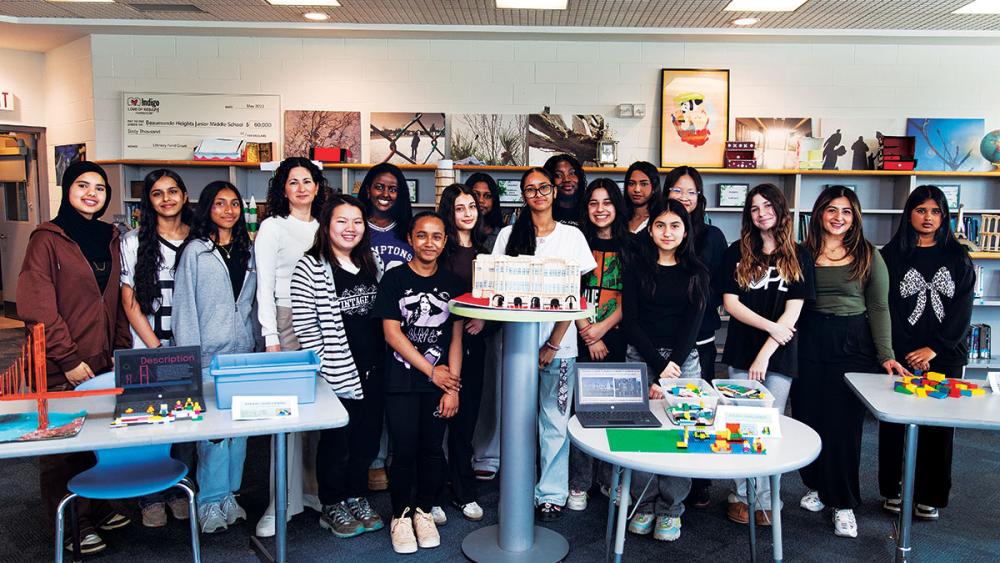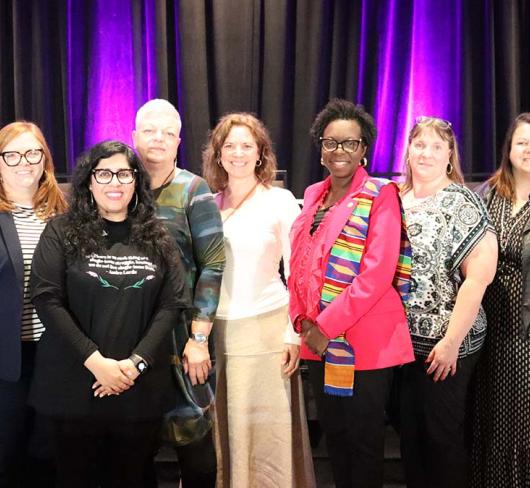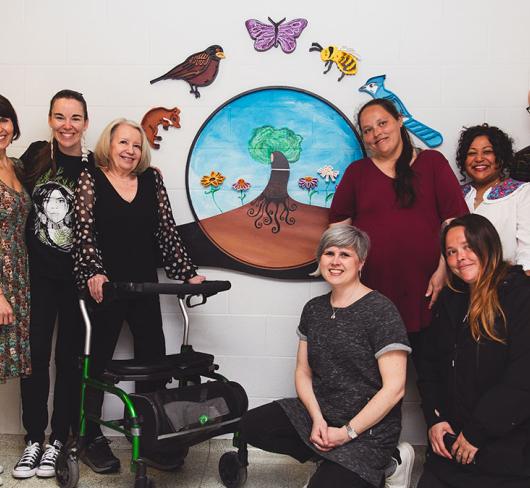
Breaking Barriers
When we started the Girls STEAM Team at Beaumonde Heights Junior Middle School, we weren’t just creating a club – we were carving out a space where girls could see themselves as builders, coders and innovators in a world that too often tells them otherwise
A few years earlier, in 2019, I had launched a school-wide initiative to encourage robotics, coding and programming in our school community. It was a lofty goal, especially for myself, since my knowledge and understanding of these areas were limited at the time. Instead of teaching these concepts myself, I created a mentorship program where older students guided younger ones.
It started off great, but something very interesting began to happen after the first few weeks: the girls stopped coming. At first, I just thought it was boredom or perhaps that the weather was becoming too warm to be indoors at lunch. But after speaking with a few of the girls who used to be regulars in the program, I learned a different story.
“The boys don’t let us do anything.”
“They told us we’re doing it wrong.”
“They keep hogging the robots!”
This was also the case when we introduced Minecraft Club in the 2023-24 school year. The boys were dominating these clubs, both in leadership and in attendance. The few girls who were keen in the beginning eventually stopped coming.
The Need for Girls-Focused STEAM Spaces
It had never occurred to me that the girls were being pushed out of participating in these STEM opportunities. In my naiveté, I assumed that the gender divide began at the post-secondary or postgraduate level, not at the tender and impressionable age of the Intermediate students I teach.
After reflecting on what had happened the previous years, I attended the Breaking Barriers: Girls in STEM conference at the ETFO office in the spring of 2024. This inspired me to make some changes to our STEM club and give it another go. At the conference, we learned some eye-opening statistics and facts. According to the World Economic Forum, “by the time girls are six years old, they are less likely to see women as ‘really, really smart’ and that same difference does not exist at age five.”
The gender gap is wide. Statistics Canada indicates that women are still less likely than men to enter STEM careers, comprising less than 30 per cent of professionals in these fields, even when they hold a degree in an area of science, technology, engineering and/or math. When they do pursue STEM careers, women continue to be underpaid compared to men in their field.
Interestingly, according to research, this gap can be narrowed by introducing girls to STEM careers at an early age. In fact, Susana González-Pérez, Ruth Mateos de Cabo, and Milagros Sáinz – researchers based in Spain who study gender representation and STEM participation – found that exposure to female role models in STEM significantly influences girls’ interest in these fields. This got me thinking: We needed to find a way to start a STEAM club for girls in order to both introduce them to a variety of career options and to the role-models they need to see.
How We Made it Work
In the summer leading up to the 2024-25 school year, I connected with our teacher-librarian, Sandy Zianis, seeking her advice and expertise on starting this club. We talked about the challenges that come with lunchtime clubs – specifically that the interest and attendance are inconsistent. If we wanted to create real change in this area for girls, we needed to ensure that we were intentional and consistent with our programming.
My Grade 8 teaching partner, Chey Cheney, was also an avid dabbler in STEM activities. If we could build the STEM club into our instructional programming, we could reach students with more impact. We proposed a block once a week where I and Ms. Zianis could meet with the girls, naming it the Girls STEAM Team, and Mr. Cheney would work with the boys.
Our administration supported this trial with the timetable.
Every week for a two-period block, the Grade 8 girls work with me and Ms. Zianis in the library learning commons, and the boys work with Mr. Cheney. Sometimes we work on the same project but in different spaces, and sometimes our focus is on completely different tasks. For example, to start our learning at the beginning of the year, we introduced the girls to Eugenia Duodu Addy, a Toronto-based chemist and the CEO of Visions of Science, a non-profit that offers STEM programming to lowincome students. In her TEDx Talk, Addy speaks of how she grew up knowing about very few women in science, and even fewer Black women, leading her to work on breaking barriers for other young women.
Presentations like this allowed us to initiate conversations about representation with the girls. Many girls talked about learning about men and women in science equally when they were really little, but somewhere along the way, STEM became more for and about boys. The girls shared with me that they used to love participating in science-related activities in Kindergarten and Grade 1, especially when they worked with their hands. This involved tasks like cooking, gardening, or making tall structures with blocks and Lego. They had no memories of learning about gender norms when engaging in these tasks in school. They do, however, remember seeing advertisements online and on television that pointed them to certain toys as they grew older. Dolls and kitchen toys became more for girls, and tools, cars and robots became “boy” toys. Since the boys were steered more towards these types of toys, many of the girls began to feel pushed out. This was exactly the stereotype we wanted to break through.
The Logistics
Through the Toronto District School Board, we applied for and received a substantial Community-Connected Experiential Learning (CCEL) grant for the work we wanted to do with our planned Girls STEAM Team, which subsequently opened several opportunities for us. We invited guest speakers – including women working in the skilled trades – to speak to the group about their experiences and the challenges they faced along their journeys. We collaborated with the Toronto Public Library to introduce our group to the TPL’s digital innovation hub to learn more about the resources that are accessible to them outside of the school environment. We took field trips, including one to Centennial College, to expose the girls to a variety of career options that are available to them in areas of STEM.
On top of the experiences we offered, we ensured that our learning was primarily hands-on. The grant allowed us to purchase consumables, which led to several tangible projects. The students created interactive identity paintings using Scratch. This project helped advance their programming skills while also tapping into their interests and loves.
We also engaged in a shoebox task (see mini-lesson), which involved repurposing an item that would have been otherwise discarded to create something that has a renewed purpose. Their ideas were incredibly innovative and creative. Some girls designed their dream vanities and jewellery cases. One student made a Beyblade game stadium, another designed a drafting table, complete with rulers and drawing tools, and there were a few very cool pencil holders and bookcases designed to fit on their desks at home. One of my favourites was a “burn box” – a prototype of a box where one could toss in pieces of paper with their negative thoughts written on them, and we could watch them burn away out of existence. Although it was not a working model, many of us thought it was a great idea to help with mental health at any age.
We also ordered an xTool through Logics Academy that can be used to laser cut and engrave on wood and metal, furthering the idea that women can be good at carpentry and more traditionally male hobbies and careers.
Impact and Student Reflections
Since joining the Girls STEAM Team, students have transformed from hesitant learners to confident STEM creators. Through exposure to STEM-related career options and hands-on building and learning, girls have had opportunities that they otherwise would not have received. One student even shared that she changed her high school program to a technical one because she learned how much she loved working with her hands. “I never knew that being an electrician was an option for me,” she told us.
Mentorship is an important part of this program. At the end of our shoebox project, we hosted an International Women’s Day fair, where the students in the Girls STEAM Team presented their projects to younger children at the school. Primary teachers brought their classes for a short presentation about International Women’s Day, and then the students circulated through the library to check out all the cool projects.
Students showed off their vending machines, vanities and games for younger students, providing mentorship and demonstrating excellence as young women in STEM fields. The girls also presented the class with information about International Women’s Day, giving them the chance to share their new thinking and knowledge around the topic of women in STEM. Teachers expressed their appreciation for the fair, as it allowed their younger students to see what they can accomplish in the coming years. A Grade 1 teacher said, “It was inspiring to see how these young women have excelled in the years since they were in our Primary classes – it truly makes me proud!”
We strongly believe that the program we have developed is essential for renewing the love for STEM that can disappear in these early years of schooling. We need to be very intentional about discussing and actively challenging the systemic obstacles that girls will encounter in their journeys in science, technology, engineering and math.
Starting Your Own Girls STEAM Team
To start a STEM program for girls, it’s important to find allies in the school community. This program would not have been successful or sustainable without the help and support of our teacher-librarian, as well as my flexible teaching partner. I also became aware of the CCEL grant opportunity through a colleague who had applied for it previously at another school. Without these connections, the program may not have made it to where it is now.
Tap into local resources like neighbouring high schools or colleges, the local public library or even industry professionals in the area. There are skilled trades workers in every community, and many would be more than happy to come in to do a talk with students to expose them to their profession.
Inquiry-based learning that looks to solve a problem in our immediate community is a great place to start with STEM projects and hands-on learning. This can be simple tasks, such as repurposing discarded materials like boxes or cartons, or it can take on larger problems, like creating accessibility features for the school building or the neighbourhood.
Mentorship should always be a natural progression with any empowerment program. Once the team starts to feel more comfortable with the work they are doing, get them to start sharing and teaching younger students. This creates a sense of wonder with younger students and also reinforces the learning that students are engaging in.
Adequate and appropriate representation in the STEM fields creates safe and inclusive learning environments for girls. We can take small steps in making sure our schools are more inclusive in STEM. “Empowerment and Advocacy” has been the motto of our Girls STEAM Team this year, and I think that as a team, we have been able to achieve success in this area. But there is still much work to be done.
Girls continue to be underrepresented in STEM fields and are still shying away from participating in STEM-related activities and clubs at school, especially as they reach adolescence. We want to create spaces where girls not only feel safe but also empowered to continue their journey with technical or scientific fields of work. Creating inclusive STEM spaces isn’t just about teaching coding – it’s about breaking systemic barriers. By developing spaces where girls feel empowered, we ensure the next generation of builders, coders and innovators includes them. The work isn’t done, but together, we can change the future of STEM.
Pawan Wander is a member of the Elementary Teachers of Toronto Local.
Mini-Lesson, Repurposing a Shoebox for STEAM Creativity
OBJECTIVE – Students are encouraged to design and build a functional object from an old shoebox (it should do something other than hold shoes)
MATERIALS – shoebox, cardboard, glue, scissors, markers, additional crafting supplies
Process
- Ideation: Employ the design thinking process to ask the question, “What kind of build could I benefit from?” Or, “What do people I know need that I can make from this shoebox?”
- Blueprinting: Students sketch a design, labelling measurements and features. They can do this by hand or using a digital blueprinting tool, such as Tinkercad.
- Building: Using craft materials, students construct their prototypes.
- Iteration: Students go through a feedback process before the final product is complete and make any necessary adjustments or refinements to their design.
- Reflection: Students explain their design choices and problem-solving challenges. This can be done presentation style, or perhaps through a design fair for younger students in the school.
Extension – Integrate more technology by incorporating coding, pulley systems, circuits (to make parts of the project interactive).
This activity reinforces the creative problem-solving mindset we foster in the Girls STEAM Team – turning overlooked materials into something innovative, just like we encourage our students to do in STEM fields.

